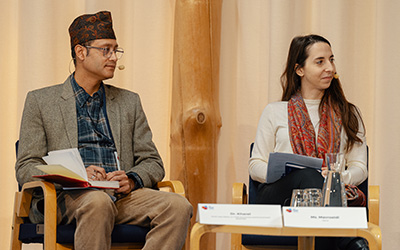Blog
The poorest countries attract few foreign investments
The share of the least developed countries (LDCs) in global foreign investments is less than one percent. But positive developments have taken place—for example, the number of startup companies has increased. This information emerged at a forum held by the Ministry for Foreign Affairs of Finland and the United Nations in Helsinki in early March.
The coronavirus pandemic, global inflation, rising interest rates, and the climate crisis have particularly impacted LDCs.
Enhancing the LDCs’ ability to manage current challenges and generate more jobs and economic growth is crucial for achieving the UN’s Sustainable Development Goals.
The LDC Future Forum, organized by the Ministry for Foreign Affairs of Finland and the UN in Helsinki from March 4–6, focused on the future of LDCs. Researchers, international organization representatives, and members of the private and public sectors, as well as civil society, discussed how innovations could support education, job creation, entrepreneurship, and economic diversification in the poorest countries.
Bangladesh and the garment industry
At the forum, Professor Selim Raihan from Dhaka University used Bangladesh as a case study to discuss the challenges LDCs face in growing their economies and improving living standards.

LDCs are often imagined as traditional agricultural countries that seek to diversify the structures of their economies and, ultimately, industrialize. In practice, however, the processes are much more complicated, and not all kinds of industrialization guarantee success.
According to Raihan, Bangladesh has been considered successful in industrialization because it has been able to develop—with the support of the public sector—the garment industry into the country's main source of export earnings and economic engine. However, the success of the ready-made garment industry has frozen the development of other industries, and Bangladesh has not been able to diversify its exports.
For example, Viet Nam has succeeded in diversifying its economy considerably better than Bangladesh. Both countries had a similar economic structure in 1995, but during the 21st century, Viet Nam managed to diversify its production and exports so that the country is now known as a producer of electronics and appliances, among other things. Viet Nam is still very dependent on its exports, but the standard of living of its citizens is clearly higher than that of Bangladeshis.
Then why did Bangladesh fall behind Viet Nam? Raihan identifies, among other things, an ‘institutional deficiency’ that prevents Bangladesh from drawing up wide-ranging industrialization plans.
‘There would be opportunities to diversify economic structures in many areas. For example, processed agricultural products, and jute and leather products could be produced in Bangladesh. In addition, the country has potential in the IT sector and light industry (such as the production of small appliances and spare parts)’.
Opportunities in food production
Aimable Nsabimana, a researcher at UNU-WIDER, also concentrated on agricultural production in his presentation.

For example, Africa has a young and growing population, which provides both labour and consumers for more refined agricultural products and foodstuffs. Africa is also urbanizing, increasing the demand for packaged and processed foods.
‘Many countries could produce, for example, flowers, houseplants, yoghurt and dried and powdered fruits and vegetables’.
According to Nsabimana, this would create jobs, but also diversify the market and improve food security.
Innovations in agriculture would still require changes in land policy, as production is now concentrated on small family farms. The road network, storage and energy supply should also be improved, and education in the field should be further developed.
Africa's digitalization is progressing slowly
Vasiliki Mavroeidi, who works as an economist at the Organisation for Economic Co-operation and Development (OECD), highlighted the opportunities offered by digitalization for the LDCs.

‘With the help of digitalization, it would be possible to speed up the green transition and the use of sustainable technologies, but also make public administration more efficient and enhance the connections between markets’.
Taking advantage of digitization is slowed down by a weak infrastructure and a lack of trained and competent workforce.
For example, the speed of internet broadband is on average six times slower in LDCs than in OECD countries. Last autumn, a modern 5G connection was only available in 400 locations in Africa but in over 80,000 in Europe.
However, Mavroeidi also saw positive progression. Ten years ago, there were almost no startups in LDCs. Now their share is around one percent of all startups in the world.
‘I see potential here, which would be good to support. Currently, only 0.01 percent of venture capital investments are targeted at startups in LDCs.’
Startup companies strive to create new business and raise work productivity to a higher level. There remains work to be done: the combined share of the 45 LDC countries in world trade and foreign investments is less than one percent—despite the fact that the countries are home to 13 percent of the world's population.
Jukka Aronen is contributing freelance journalist for Kehitys-Utveckling magazine.
The views expressed in this piece are those of the author(s), and do not necessarily reflect the views of the Institute or the United Nations University.
Translation from Finnish by Anna Toppari
 Join the network
Join the network



